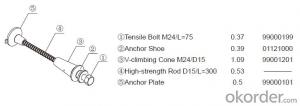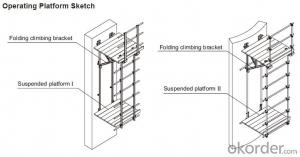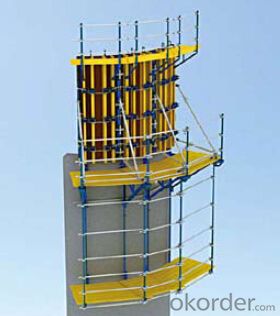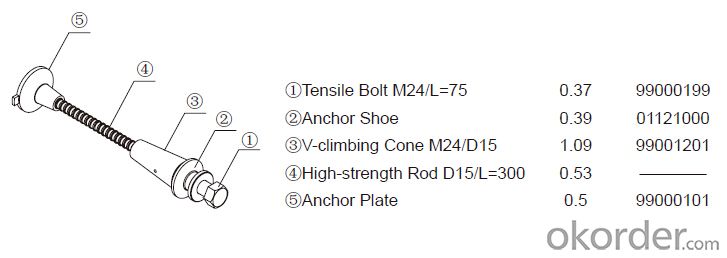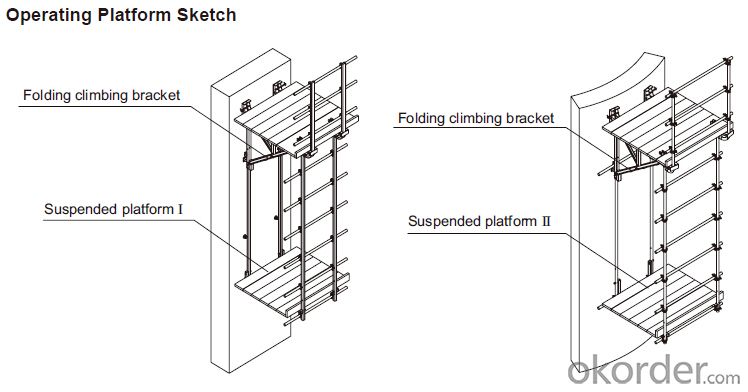Climbing-platform CP190 for formwork and scaffolding system
- Loading Port:
- Tianjin
- Payment Terms:
- TT OR LC
- Min Order Qty:
- 50 m²
- Supply Capability:
- 1000 m²/month
OKorder Service Pledge
OKorder Financial Service
You Might Also Like
Climbing Platform CP190
Climbing bracket CP190 is mainly used as operating platform during construction. It can be used
on the vertical wall and arced wall. The bracket hang on the anchor system and all the load are
supported by anchor system. It’s convenient to assemble and dismantle, the construction is easy,
rapid and safe.
Anchor System:
Anchor system is the most important supporting part. The system is made of five parts shown
below. There into, tensile bolt, anchor shoe and V-climbing cone can be taken out for reusing.
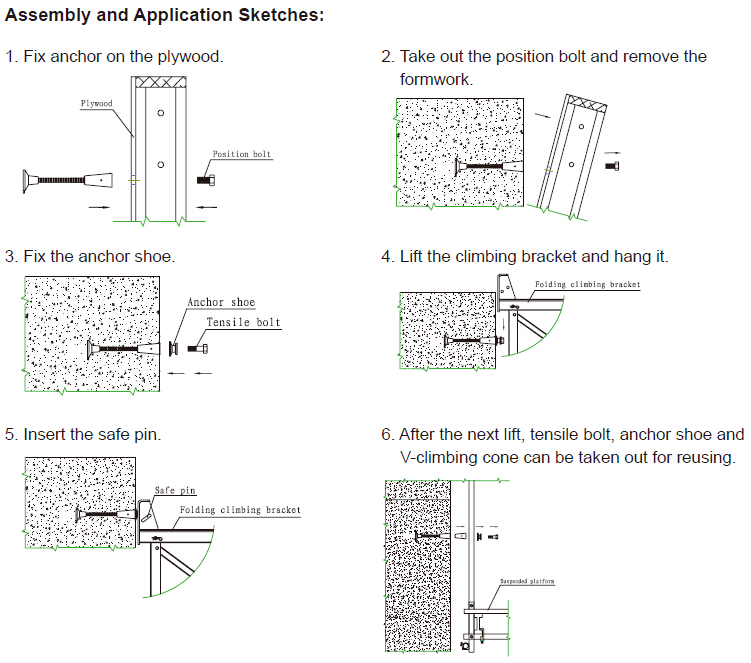
- Q: Can steel formwork be used for both horizontal and vertical concrete placements?
- Indeed, both horizontal and vertical concrete placements can utilize steel formwork. The utilization of steel formwork offers a robust and sturdy framework, rendering it appropriate for a wide range of concrete placements. Its durability and stability enable it to endure the force exerted by the moist concrete, guaranteeing the preservation of its shape and structure throughout the curing phase. Steel formwork exhibits versatility, enabling convenient customization and assembly to fulfill the precise demands of horizontal and vertical concrete placements. Regardless of whether it pertains to the construction of slabs, walls, columns, or beams, steel formwork serves as a dependable and effective solution for generating superior concrete structures.
- Q: What are the common design considerations for steel formwork systems?
- To ensure a successful construction project, it is important to take into account several design considerations for steel formwork systems. First and foremost, the load-bearing capacity of the steel formwork system is crucial. It must be able to safely support the weight of the poured concrete as well as any additional loads like workers and equipment. Calculations and analysis are necessary to determine the appropriate thickness and reinforcement of the steel formwork. In addition, the formwork system should be designed to provide sufficient stability and resistance against lateral forces. This is especially important for tall or complex structures that may be subject to significant wind or seismic loads. The design should incorporate bracing and anchorage systems to ensure stability throughout construction. Another important consideration is the ease of assembly and disassembly of the steel formwork system. The design should facilitate efficient installation and removal, minimizing labor and time requirements. This can be achieved through the use of modular components and standardized connections that are easy to assemble and dismantle. Furthermore, the formwork system should be adaptable to any necessary adjustments or modifications. Construction projects often require changes during the process, and the formwork should be flexible enough to accommodate these changes without compromising its structural integrity. Safety is also a crucial aspect in the design of steel formwork systems. The formwork should provide a safe working environment for construction workers, incorporating features like handrails, access platforms, and non-slip surfaces. Additionally, potential hazards such as sharp edges or protruding elements should be considered, and appropriate safety measures should be incorporated to mitigate these risks. Lastly, the durability and longevity of the steel formwork system should be taken into consideration. It should be designed to withstand the harsh conditions of construction, including exposure to weather, chemicals, and repeated use. This may involve the use of corrosion-resistant materials or protective coatings to ensure the longevity and performance of the formwork system. In conclusion, there are several important design considerations for steel formwork systems, including load-bearing capacity, stability against lateral forces, ease of assembly and disassembly, adaptability to changes, safety features, and durability. By carefully considering these factors, engineers can design a steel formwork system that meets the specific requirements of a construction project and ensures its successful execution.
- Q: What are the considerations for designing steel formwork systems?
- When designing steel formwork systems, there are several important considerations that need to be taken into account. These considerations include: 1. Load-bearing capacity: Steel formwork systems must be designed to withstand the loads imposed by the concrete during pouring and curing. This includes the weight of the concrete, as well as any additional loads such as equipment or workers. 2. Safety: The safety of workers is of utmost importance when designing steel formwork systems. The system should be designed to provide a stable and secure working platform, with proper guardrails, access points, and fall protection measures. 3. Durability: Steel formwork systems should be designed to withstand the harsh conditions of construction sites, including exposure to weather elements, chemicals, and repeated use. The materials used should be corrosion-resistant and able to maintain their structural integrity over time. 4. Flexibility and adaptability: The design of the steel formwork system should allow for easy assembly, disassembly, and reusability. It should be adaptable to different project requirements and able to accommodate changes in design or construction methods. 5. Cost-effectiveness: The overall cost of the steel formwork system, including its initial investment, maintenance, and lifespan, should be considered. Designing a system that balances cost with performance and durability is essential. 6. Construction schedule: The design of the steel formwork system should take into account the construction schedule and the time required for assembly, concrete pouring, and formwork removal. The system should be designed to minimize downtime and facilitate efficient construction processes. 7. Environmental impact: Consideration should be given to the environmental impact of the steel formwork system, such as the use of sustainable materials, recycling options, and minimizing waste generation. Overall, designing steel formwork systems requires a comprehensive approach that takes into account structural integrity, safety, durability, flexibility, cost-effectiveness, construction schedule, and environmental factors. By considering these considerations, a well-designed steel formwork system can greatly contribute to the success of a construction project.
- Q: How does steel formwork handle concrete shrinkage and cracking?
- Steel formwork is a versatile and durable option when it comes to dealing with concrete shrinkage and cracking. Its design ensures support and stability during the pouring and curing process, effectively minimizing the negative effects of shrinkage and cracking. One of the main benefits of steel formwork is its capacity to withstand the pressure exerted by shrinking concrete. Steel is a resilient material that can resist the forces generated by the drying and hardening of the concrete. As a result, the formwork remains intact and does not deform or collapse under the weight of the shrinking concrete. Moreover, steel formwork often incorporates expansion joints or other flexible components that can accommodate the movement caused by shrinkage and cracking. These joints allow the formwork to expand and contract in sync with the concrete, reducing stress on the structure and minimizing the risk of cracks. Additionally, steel formwork can be easily reinforced or supplemented with additional support elements, like braces or tie rods, to further enhance its ability to handle concrete shrinkage and cracking. These reinforcements ensure the forces exerted by the shrinking concrete are evenly distributed across the formwork, decreasing the likelihood of localized cracking or structural failure. In summary, steel formwork is a reliable and robust solution for effectively managing concrete shrinkage and cracking. Its strength, flexibility, and capacity for reinforcement make it an ideal choice for construction projects where minimizing the impact of these issues is of utmost importance.
- Q: How does steel formwork affect the overall construction waste generation?
- Steel formwork can significantly reduce the overall construction waste generation in several ways. Firstly, steel formwork is reusable, which means it can be used multiple times for different projects. Unlike traditional timber formwork, which often needs to be disposed of after a single use, steel formwork can be dismantled, transported, and reassembled for use in future construction projects. This reduces the amount of waste generated from formwork materials. Additionally, steel formwork is more durable and resistant to damage compared to other types of formwork. It can withstand greater pressure and is less likely to deform or break during the construction process. This durability reduces the need for frequent replacements and repairs, further minimizing waste generation. Moreover, steel formwork allows for precise and accurate construction, resulting in less material wastage. Its rigid structure ensures that concrete is poured and cured in the desired shape and dimensions, reducing the need for excessive concrete pouring or trimming. This eliminates unnecessary material usage and reduces the amount of construction waste generated. Furthermore, steel formwork is easier to clean and maintain compared to other formwork materials. It can be cleaned and repaired more efficiently, reducing the chances of material degradation and the need for replacement. This not only extends the lifespan of the formwork but also reduces the waste generated from discarded or damaged formwork materials. Overall, the use of steel formwork in construction projects has a positive impact on waste generation. Its reusability, durability, accuracy, and ease of maintenance contribute to minimizing the amount of construction waste generated, making it a more sustainable option for formwork in the construction industry.
- Q: Can steel formwork be used in high-temperature environments?
- Yes, steel formwork can be used in high-temperature environments. Steel is a durable and heat-resistant material that can withstand elevated temperatures without deformation or structural damage. It is commonly used in construction projects, including those in high-temperature environments such as foundries or industrial facilities.
- Q: What are the different types of lifting systems used with steel formwork?
- There are several types of lifting systems commonly used with steel formwork in construction projects. These lifting systems are designed to facilitate the transportation and installation of steel formwork panels, which are used to create the molds for concrete structures. Here are some of the different types of lifting systems used with steel formwork: 1. Crane lifting system: This is one of the most common and widely used lifting systems. It involves using cranes with hooks or specialized lifting attachments to lift and move the steel formwork panels to their desired location. Cranes provide the necessary strength and stability to handle heavy loads and are often used in large-scale construction projects. 2. Forklift lifting system: Forklifts are another popular option for lifting and moving steel formwork panels. These vehicles are equipped with forks that can slide under the formwork and lift it off the ground. Forklifts are particularly useful in smaller construction sites or areas with limited space, where cranes may not be feasible. 3. Hydraulic lifting system: Hydraulic systems utilize hydraulic power to lift and move the steel formwork panels. These systems are often integrated into the formwork itself, allowing for controlled lifting and lowering of the panels. Hydraulic lifting systems are known for their precision and ease of use. 4. Manual lifting system: In some cases, manual labor is used to lift and move steel formwork panels. This method typically involves a team of workers using ropes, chains, or other lifting tools to manually hoist the formwork into position. Manual lifting systems are usually employed for smaller formwork panels or in situations where other lifting systems are not available. 5. Self-climbing lifting system: Self-climbing systems are commonly used in high-rise construction projects. These systems are designed to lift and move the steel formwork vertically as the construction progresses. They often utilize hydraulic or mechanical mechanisms to lift the formwork to the next level, allowing for efficient and continuous construction. 6. Tower crane lifting system: Tower cranes are tall, freestanding cranes that are commonly used in large construction projects. They can lift and move steel formwork panels to various heights and locations on the construction site. Tower cranes offer excellent reach and versatility, making them suitable for projects with complex formwork requirements. Overall, the choice of lifting system for steel formwork depends on factors such as the size and weight of the formwork panels, the construction site's characteristics, and the specific requirements of the project. It is important to select the appropriate lifting system to ensure the safe and efficient installation of steel formwork.
- Q: Can steel formwork be used for underground culverts?
- Yes, steel formwork can be used for underground culverts. Steel formwork is known for its durability, strength, and ability to withstand heavy loads and pressure. This makes it suitable for constructing underground culverts, which are designed to carry water, sewage, or other fluids below the ground surface. Steel formwork provides a rigid structure that can withstand the weight of the soil and any traffic loads above it, ensuring the stability and longevity of the culvert. Additionally, steel formwork is versatile and can be easily customized to accommodate different sizes and shapes of culverts. Overall, steel formwork is a reliable and efficient choice for constructing underground culverts.
- Q: Can steel formwork be used for both regular and irregular concrete shapes?
- Steel formwork is capable of being utilized for both regular and irregular concrete shapes. Its versatility and strength are well-known attributes, rendering it suitable for managing diverse concrete shapes and sizes. By means of techniques like cutting, bending, or welding, steel formwork can be effortlessly tailored and adjusted to accommodate irregular shapes. The adaptability of steel formwork permits its usage in a vast array of construction undertakings, including those entailing irregular concrete shapes. Nevertheless, it is crucial to exercise caution when designing and fabricating the steel formwork, guaranteeing adequate support and stability for the concrete during the pouring and curing stages.
- Q: How does steel formwork affect the overall fire resistance of a structure?
- Steel formwork does not directly affect the overall fire resistance of a structure as it is primarily used for temporary support during concrete pouring and construction. The fire resistance of a structure is generally determined by the materials used in its construction, such as the type of concrete, insulation, and fireproofing systems. However, steel formwork can indirectly contribute to the fire resistance by ensuring the proper placement and compaction of concrete, which is a key factor in achieving the desired fire resistance rating. The strength and durability of the concrete, when properly mixed and compacted, can enhance the overall fire resistance of the structure. Additionally, steel formwork can provide a smooth and uniform surface finish, which can facilitate the application of fireproofing materials. Fireproofing coatings or sprays are often used to enhance the fire resistance of structural elements, such as beams and columns. The smooth surface provided by steel formwork can help ensure an even and effective application of these fireproofing materials, further enhancing the fire resistance of the structure. It is important to note that while steel formwork itself is not fire resistant, it is typically removed once the concrete has cured, and the final fire resistance of the structure is determined by the materials used in its permanent construction.
Send your message to us
Climbing-platform CP190 for formwork and scaffolding system
- Loading Port:
- Tianjin
- Payment Terms:
- TT OR LC
- Min Order Qty:
- 50 m²
- Supply Capability:
- 1000 m²/month
OKorder Service Pledge
OKorder Financial Service
Similar products
Hot products
Hot Searches
Related keywords

